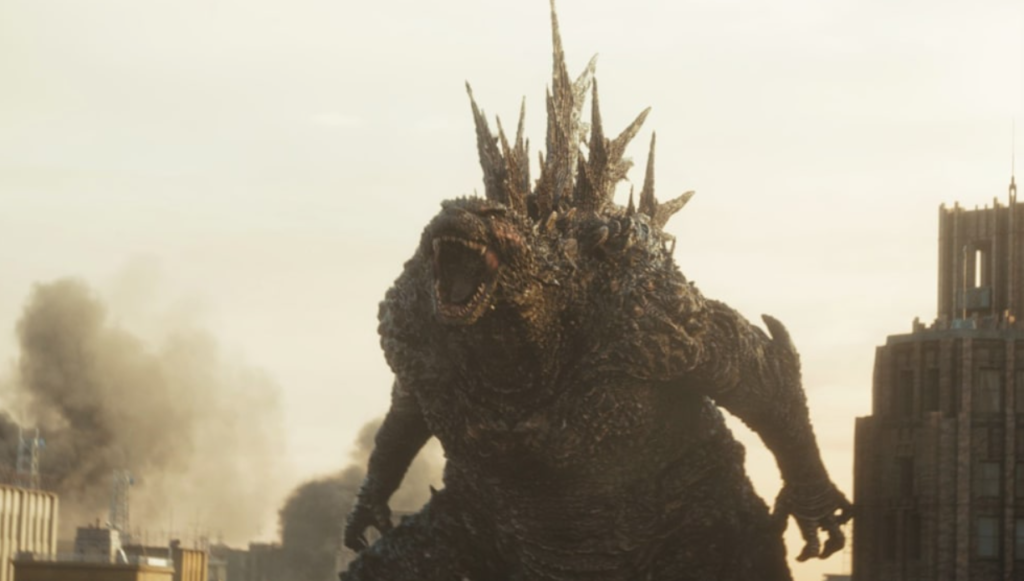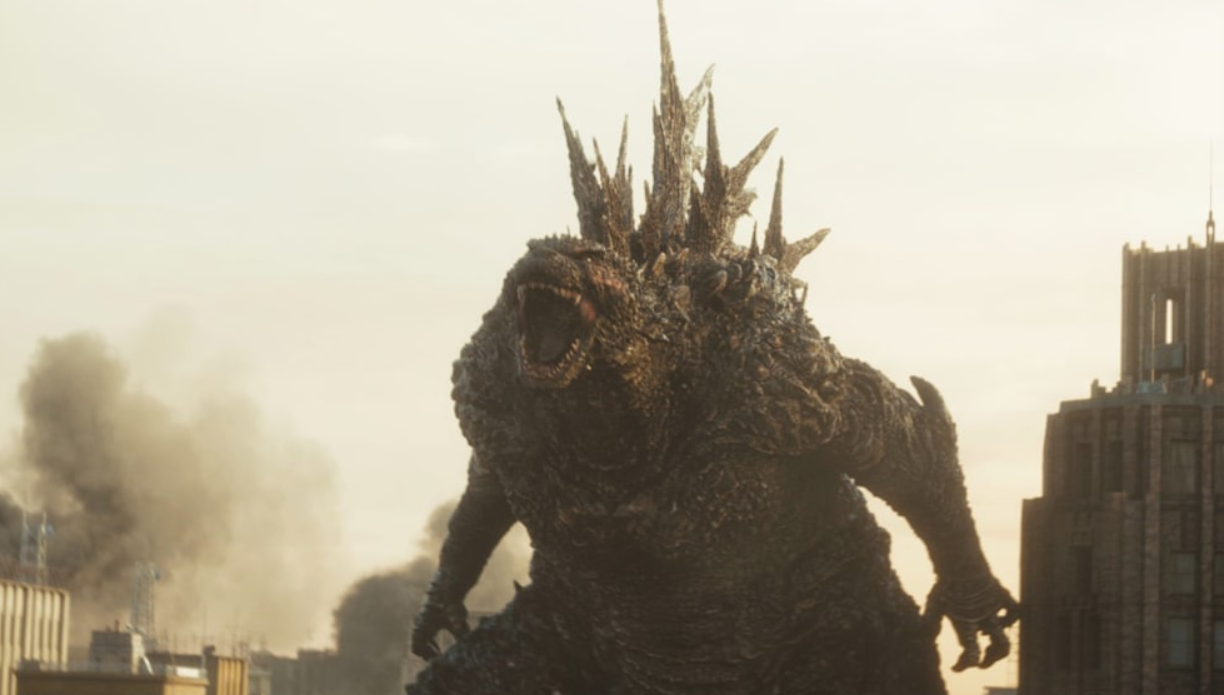
When it comes to bringing Godzilla to thrilling, terrifying life, America’s track record has been spotty at best, marked by a few minor highs and lots of lows (virtually everything else, including Apple TV+’s current Monarch: Legacy of Monsters). Not so, however, in his homeland. As Toho Studios’ new Godzilla Minus One proves, the Japanese know how to get the iconic radioactive behemoth right.
The 37th feature in the 70-year-old franchise, and arguably one of its finest, Godzilla Minus One, which hits theaters Dec. 1, harkens back to the kaiju’s 1954 origins, yet is far from merely a nostalgia play. On the contrary, Takashi Yamazaki’s film is a faithful update that, like its 2016 predecessor Shin Godzilla, melds then and now with blockbuster-grade brawniness. Skillfully balancing its human- and titan-sized concerns, and going light on socio-political allegory in favor of muscular mayhem, it delivers just about everything fans could want from a sequel—including plentiful larger-than-life chaos and madness.
Writer/director Yamazaki wastes not a second getting to the good stuff, as no sooner has WWII kamikaze fighter pilot Koichi Shikishima (Ryunosuke Kamiki) landed on Odo island in 1945 to have his faulty craft repaired than he and the rest of the island’s military inhabitants are beset by Godzilla, who’s at this early stage less a skyscraper-tall monster than an overgrown dinosaur. If his stature is relatively small, though, his ferocious temper is already mature, and he viciously decimates everyone and everything in his path. In the morning, the sole survivors of this massacre are mechanic Sosaku Tachibana (Munetaka Aoki) and Koichi, and the former largely blames the latter for these casualties due to the fact that the pilot had Godzilla in his plane’s gun sights but, at the moment of truth, froze.
Upon returning to decimated Tokyo, Koichi is haunted by the ghosts of his fallen comrades and plagued by guilt over his cowardly failure to fulfill his duty as a kamikaze pilot and to act against the prehistoric marauder. Via the sort of twists of fate that largely happen only in the movies, Koichi acquires a surrogate family in fetching Noriko Oishi (Minami Hamabe) and baby Akiko (Sae Nagatani), whom Noriko took in after the child’s parents perished in the Tokyo air raids. Yamazaki doesn’t exert excessive energy trying to sell this as believable, since corny contrivances are part and parcel of his cine-spectacular storytelling approach, which later involves a random character revealing himself to be a brilliant naval expert. Still, Kamiki and Hamabe have chemistry and their dynamic is smartly positioned as a microcosm of Japan’s uneasy post-war attempts to overcome trauma, heal, and unite.
That process, unsurprisingly, is complicated by Godzilla. Godzilla Minus One offers up a fleeting montage of American intelligence reports to explain how nuclear testing at Bikini Atoll supersized the brute, and then swiftly pits him against Koichi and his coworkers (and friends)—captain Yoji Akitsu (Kuranosuke Sasaki), brainiac Kenji Noda (Hidetaka Yoshioka), and rookie Shiro Mizushima (Yuki Yamada)—aboard a pitiful wooden ship that they’re using to clear some of the 60,000 mines still littered off the Japanese coast. They’re of course no match for their gargantuan adversary, yet Yamazaki devises smart ways to have them survive in the face of this seemingly unstoppable threat. In every big action set piece, the filmmaker’s plotting is as sharp as Godzilla is brutal.
Godzilla Minus One doesn’t skimp on sequences of its main attraction doing what he does best, and in its bookending aquatic showstoppers, it more than faintly becomes a steroidal version of Jaws, complete with the creature’s fin-like dorsal plates cutting through the water as he stalks his prey from beneath the surface. However, whereas Spielberg famously minimized clear glimpses of his marine monster to heighten suspense (and, also, to hide its subpar construction and unconvincing appearance), Yamazaki revels in reverentially depicting his atomic-powered fiend, affording copious views of his title character as he savagely roars and rampages. Resembling his classic form but juiced to awe-inspiringly burly proportions—especially with regards to his powerlifter-grade thighs—Godzilla looks awesome, and the director knows how to shoot him to elicit both wonder and horror, never more so than in an image of the colossus bellowing at the base of a mushroom cloud caused by his destructive heat ray.
In such moments, as well as in Koichi’s struggle to deal with his PTSD as well as the shame and remorse of his wartime shortcomings, Godzilla Minus One acknowledges Godzilla’s historical roots as well as the country’s difficult literal and spiritual reconstruction. Nonetheless, the film finds hope amidst its despondency, and just as shrewdly, it doesn’t allow its obvious undercurrents to interfere with its basic monster-mash obj
ectives. If Godzilla’s initial clash with Koichi and his mates at sea is nerve-wracking, his subsequent landfall in Tokyo’s Ginza district is exhilarating, with the director paying homage to his illustrious predecessors with every composition of the beast’s feet crashing to (and through) the street as pedestrians flee in panic, and of his fists and tail pummeling and swiping through buildings as if they were made of cottage cheese. Its kicks are at once old-school breathtaking and new-age violent.
Kamiki has a tendency to overemote and his costars fall short of making their supporting characters truly memorable—an inadequacy that can largely be pinned on the script’s reasonable desire to wedge in as much Godzilla pandemonium as possible, which in the final tally comes off as a fair trade. Moreover, Godzilla Minus One adheres to a familiar American summer-extravaganza playbook that renders its late surprises predictable and compels it to conclude with comforting (personal and national) triumph rather than the catastrophic tragedy it’s spent most of its 125 minutes teasing. Even so, there’s considerable pleasure to be had from watching a talented craftsman ply his trade, and Yamazaki exhibits a knack for balancing ground-level sorrow, fear, and joy with epic carnage and calamity. When those two forces meet—say, during close-ups of Noriko, Yoji or other soldiers gazing in dumbstruck astonishment at the scaly giant—the film hits the spine-tingling sweet spot that all Godzilla efforts seek.
